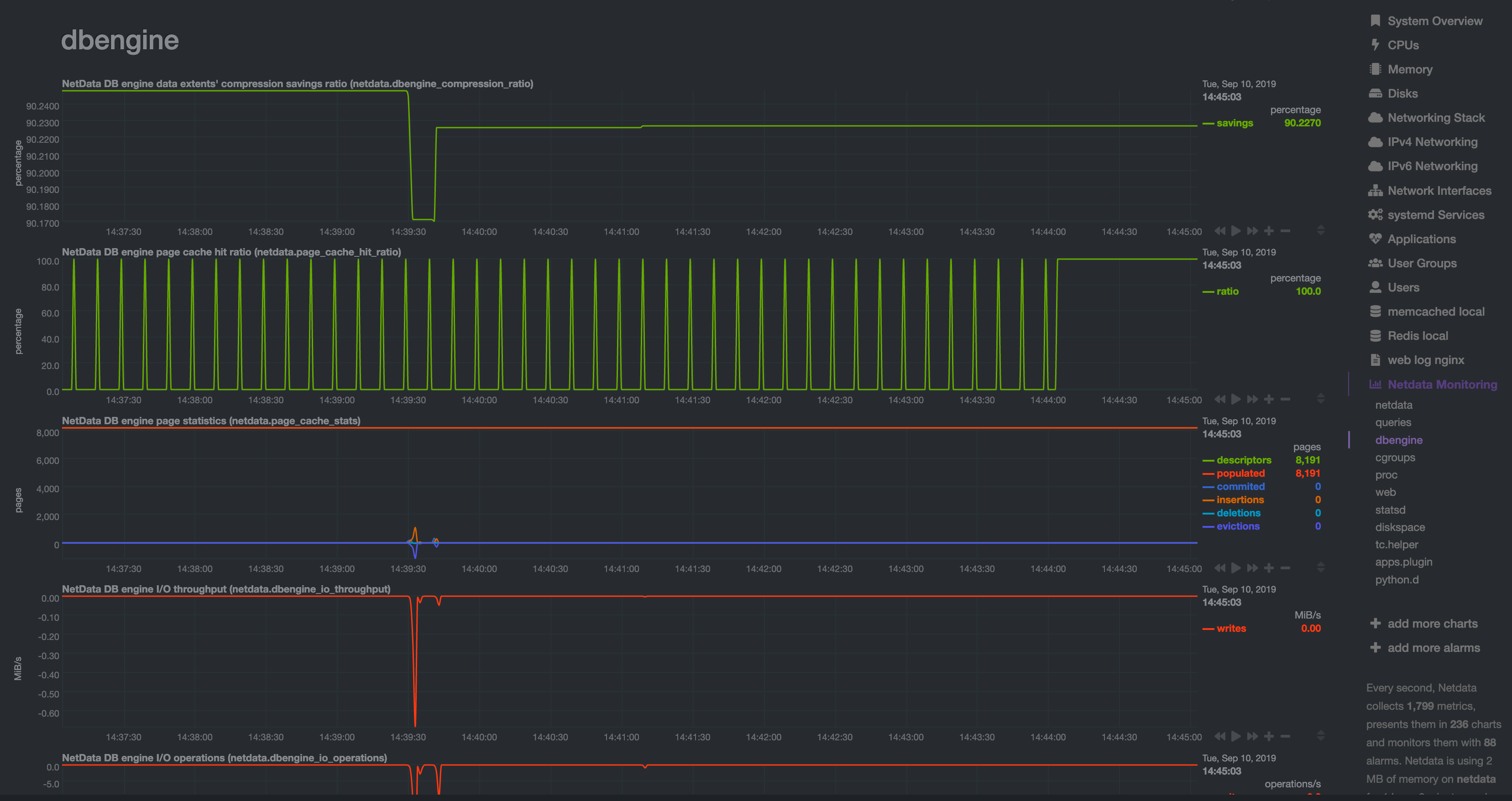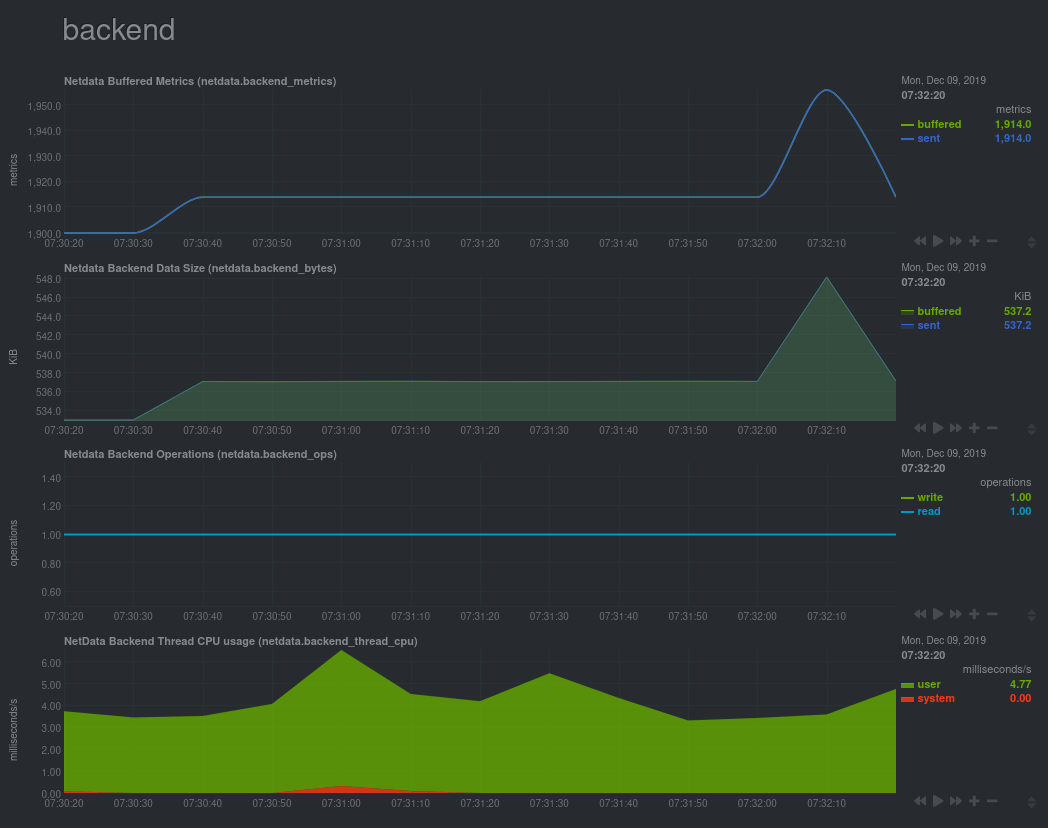diff options
Diffstat (limited to 'docs/guides/step-by-step/step-09.md')
| -rw-r--r-- | docs/guides/step-by-step/step-09.md | 162 |
1 files changed, 0 insertions, 162 deletions
diff --git a/docs/guides/step-by-step/step-09.md b/docs/guides/step-by-step/step-09.md deleted file mode 100644 index 839115a27..000000000 --- a/docs/guides/step-by-step/step-09.md +++ /dev/null @@ -1,162 +0,0 @@ -<!-- -title: "Step 9. Long-term metrics storage" -custom_edit_url: https://github.com/netdata/netdata/edit/master/docs/guides/step-by-step/step-09.md ---> - -# Step 9. Long-term metrics storage - -By default, Netdata stores metrics in a custom database we call the [database engine](https://github.com/netdata/netdata/blob/master/database/engine/README.md), which -stores recent metrics in your system's RAM and "spills" historical metrics to disk. By using both RAM and disk, the -database engine helps you store a much larger dataset than the amount of RAM your system has. - -On a system that's collecting 2,000 metrics every second, the database engine's default configuration will store about -two day's worth of metrics in RAM and on disk. - -That's a lot of metrics. We're talking 345,600,000 individual data points. And the database engine does it with a tiny -a portion of the RAM available on most systems. - -To store _even more_ metrics, you have two options. First, you can tweak the database engine's options to expand the RAM -or disk it uses. Second, you can archive metrics to an external database. For that, we'll use MongoDB as examples. - -## What you'll learn in this step - -In this step of the Netdata guide, you'll learn how to: - -- [Tweak the database engine's settings](#tweak-the-database-engines-settings) -- [Archive metrics to an external database](#archive-metrics-to-an-external-database) - - [Use the MongoDB database](#archive-metrics-via-the-mongodb-exporting-connector) - -Let's get started! - -## Tweak the database engine's settings - -If you're using Netdata v1.18.0 or higher, and you haven't changed your `memory mode` settings before following this -guide, your Netdata agent is already using the database engine. - -Let's look at your `netdata.conf` file again. Under the `[global]` section, you'll find three connected options. - -```conf -[db] - # mode = dbengine - # dbengine page cache size MB = 32 - # dbengine disk space MB = 256 -``` - -The `memory mode` option is set, by default, to `dbengine`. `page cache size` determines the amount of RAM, in MiB, that -the database engine dedicates to caching the metrics it's collecting. `dbengine disk space` determines the amount of -disk space, in MiB, that the database engine will use to store these metrics once they've been "spilled" to disk.. - -You can uncomment and change either `page cache size` or `dbengine disk space` based on how much RAM and disk you want -the database engine to use. The higher those values, the more metrics Netdata will store. If you change them to 64 and -512, respectively, the database engine should store about four day's worth of data on a system collecting 2,000 metrics -every second. - -[**See our database engine calculator**](https://github.com/netdata/netdata/blob/master/docs/store/change-metrics-storage.md) to help you correctly set `dbengine disk -space` based on your needs. The calculator gives an accurate estimate based on how many child nodes you have, how many -metrics your Agent collects, and more. - -```conf -[db] - mode = dbengine - dbengine page cache size MB = 64 - dbengine disk space MB = 512 -``` - -After you've made your changes, restart Netdata using `sudo systemctl restart netdata`, or the [appropriate -method](https://github.com/netdata/netdata/blob/master/docs/configure/start-stop-restart.md) for your system. - -To confirm the database engine is working, go to your Netdata dashboard and click on the **Netdata Monitoring** menu on -the right-hand side. You can find `dbengine` metrics after `queries`. - - - -## Archive metrics to an external database - -You can archive all the metrics collected by Netdata to **external databases**. The supported databases and services -include Graphite, OpenTSDB, Prometheus, AWS Kinesis Data Streams, Google Cloud Pub/Sub, MongoDB, and the list is always -growing. - -As we said in [step 1](https://github.com/netdata/netdata/blob/master/docs/guides/step-by-step/step-01.md), we have only complimentary systems, not competitors! We're -happy to support these archiving methods and are always working to improve them. - -A lot of Netdata users archive their metrics to one of these databases for long-term storage or further analysis. Since -Netdata collects so many metrics every second, they can quickly overload small devices or even big servers that are -aggregating metrics streaming in from other Netdata agents. - -We even support resampling metrics during archiving. With resampling enabled, Netdata will archive only the average or -sum of every X seconds of metrics. This reduces the sheer amount of data, albeit with a little less accuracy. - -How you archive metrics, or if you archive metrics at all, is entirely up to you! But let's cover two easy archiving -methods, MongoDB and Prometheus remote write, to get you started. - -### Archive metrics via the MongoDB exporting connector - -Begin by installing MongoDB its dependencies via the correct package manager for your system. - -```bash -sudo apt-get install mongodb # Debian/Ubuntu -sudo dnf install mongodb # Fedora -sudo yum install mongodb # CentOS -``` - -Next, install the one essential dependency: v1.7.0 or higher of -[libmongoc](http://mongoc.org/libmongoc/current/installing.html). - -```bash -sudo apt-get install libmongoc-1.0-0 libmongoc-dev # Debian/Ubuntu -sudo dnf install mongo-c-driver mongo-c-driver-devel # Fedora -sudo yum install mongo-c-driver mongo-c-driver-devel # CentOS -``` - -Next, create a new MongoDB database and collection to store all these archived metrics. Use the `mongo` command to start -the MongoDB shell, and then execute the following command: - -```mongodb -use netdata -db.createCollection("netdata_metrics") -``` - -Next, Netdata needs to be [reinstalled](https://github.com/netdata/netdata/blob/master/packaging/installer/REINSTALL.md) in order to detect that the required -libraries to make this exporting connection exist. Since you most likely installed Netdata using the one-line installer -script, all you have to do is run that script again. Don't worry—any configuration changes you made along the way will -be retained! - -Now, from your Netdata config directory, initialize and edit a `exporting.conf` file to tell Netdata where to find the -database you just created. - -```sh -./edit-config exporting.conf -``` - -Add the following section to the file: - -```conf -[mongodb:my_mongo_instance] - enabled = yes - destination = mongodb://localhost - database = netdata - collection = netdata_metrics -``` - -Restart Netdata using `sudo systemctl restart netdata`, or the [appropriate -method](https://github.com/netdata/netdata/blob/master/docs/configure/start-stop-restart.md) for your system, to enable the MongoDB exporting connector. Click on the -**Netdata Monitoring** menu and check out the **exporting my mongo instance** sub-menu. You should start seeing these -charts fill up with data about the exporting process! - - - -If you'd like to try connecting Netdata to another database, such as Prometheus or OpenTSDB, read our [exporting -documentation](https://github.com/netdata/netdata/blob/master/exporting/README.md). - -## What's next? - -You're getting close to the end! In this step, you learned how to make the most of the database engine, or archive -metrics to MongoDB for long-term storage. - -In the last step of this step-by-step guide, we'll put our sysadmin hat on and use Nginx to proxy traffic to and from -our Netdata dashboard. - -[Next: Set up a proxy →](https://github.com/netdata/netdata/blob/master/docs/guides/step-by-step/step-10.md) - - |
